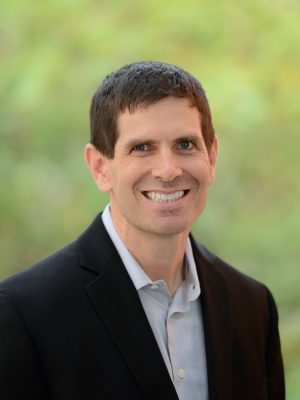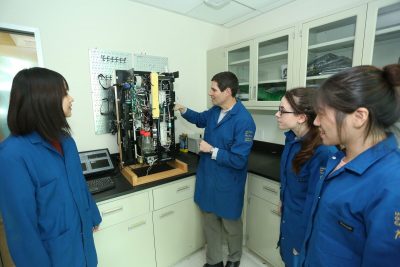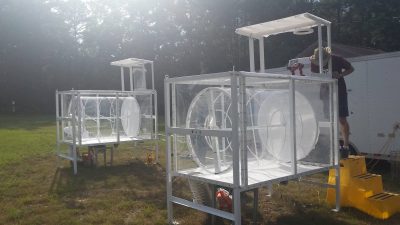
To understand how nucleated particles develop, one scientist will take to the field with an aerosol growth chamber
Officially, atmospheric scientist Donald R. “Don” Collins is a professor of chemical and environmental engineering at the University of California, Riverside.
Such a broad title, however, does not reveal that he grew up near Washington, D.C., drinks his coffee black, always liked to tinker with machines, and that he once did field work in Tasmania.
Most of all, the title barely hints at the work Collins does as an investigator of the tropospheric aerosols that shape clouds and that scatter and absorb radiation.
He is asking lately: How do the very smallest ones form, grow, and age? How does what they are made of matter? How are they affected by trace gases?
Such questions are part of a high-stakes branch of science.
Sky-borne aerosols, in large measure, influence rates of precipitation, atmospheric radiation and optics, and air chemistry (including air pollution). A fraction of these particles—cloud condensation nuclei (CCN)—are the physical substrates on which water vapor condenses to form cloud droplets.
The fraction of small particles that become CCN (through condensational growth and oxidation) are of special interest to Collins.
Aerosols are suspensions of gases and solid or liquid particles (or a mixture of both) that have consequences that belie their tiny dimensions. Their diameters can be as small as 1 nanometer—100,000 times thinner than a sheet of paper.
Clouds are the most visible manifestation of planet Earth’s water cycle, from a puff of cumulus 100 meters wide to a vast field of marine stratocumulus that stretch across the sky in decks hundreds of kilometers across. The tiny particles that Collins studies at both regional and global scales in large part determine the microphysics of clouds and the precipitation they engender.
Aerosol particles come from biological sources such as pollen, fungi, or organic matter entrained in the spray from ocean waves. They come from tilled soils stirred into the air by wind and are created by biomass burning and fuel combustion. They can form from reactions of sulfur, nitrogen, and other gases.
For Collins, this is such stuff as science is made on.
A First-Time Chamber

Aerosols affect the earth’s climate by influencing the reflectivity and lifetime of clouds. But that only applies to particles larger than 50 nanometers or so—the ones large enough to have cloud droplets form around them.
But what about atmospheric particles 50 times smaller? These “fresh,” tiny, and new particles, with a lifespan of just minutes or hours, must grow big enough and fast enough to minimize the chance they will be lost to coagulation with others.
These new nucleated particles are the subject of a 2018-2021 project that Collins is leading s principal investigator for the U.S. Department of Energy’s (DOE) Atmospheric System Research (ASR) program. The work is designed to improve what we know about the processes that control the growth and atmospheric processing of these small particles.
In part, that new understanding requires routine daily aerosol measurements taken at the Southern Great Plains (SGP) atmospheric observatory in Oklahoma, a fixed site administered since 1992 by the DOE’s Atmospheric Radiation Measurement (ARM) user facility.
In mid-August 2019, Collins and a team of three graduate students will be at SGP with a kind of secret weapon for studying small nucleated particles: a captive aerosol growth and evolution (CAGE) chamber.
About the size of two refrigerators, including its housing, CAGE is the first chamber of its kind to be used in the field.
Throughout the world, Teflon environmental chambers with many of the same characteristics and functionality are built within indoor rooms and can be very large, even the size of small houses. To fabricate a field-ready chamber, the only size constraint is the size of the nearest freight elevator or doorway.
The resulting awards come in only one size: big.
Outdoors, the resulting data on growth and property changes from CAGE “can provide details about the way the particles behave in the atmosphere,” says Collins, including the degree to which they take up water.
Now in its third generation, CAGE was conceived, designed, and developed by Collins when he was at Texas A&M University.
He taught and did atmospheric research there from 1999 to 2018, starting fresh from his doctoral studies. In his first few years in Texas, Collins focused on ambient aerosol measurements using standard field instruments, including those that collect particles on filters.
CAGE, he says, is not about samples but exciting new data.
Injection, Inspection

CAGE’s cylindrical chamber is made largely of a light-transmitting Teflon that allows the ultraviolet and spectral intensity inside to match that of the outside.
At one end of the cylinder, a gas-permeable seal allows the exchange of water vapor and trace gases between outside and inside. In effect, the chamber creates a contained, near-ambient atmosphere to make observing small-particle changes easier than conventional methods.
In the field at SGP, researchers will inject a cohort of small particles of the same size and known chemical composition into the chamber, which has an internal volume of about 2 cubic meters. (In the beginning, at Texas A&M, Collins used soot, inspired by DOE missions at the time that were tracking air masses as they advect downwind from urban settings or sites of biomass burning.)
From there, over periods of minutes to several hours to more than a day, observers will record changing particle sizes and properties.
“These chambers are good for defining, very well, the initial conditions of fresh particles, including how big they are,” says Collins. “At any time during the experiment, we can see how they change. That’s not possible with ambient measurements.”
A second chamber alongside the first will serve as a control. It will also allow researchers to study deliberate perturbations they introduce—the delivery of another trace gas, for instance.
The first field experiment at SGP will take place from August through late October 2019. A second, to test springtime conditions, will unfold from mid-April through June 20, 2020.
New particle formation and growth are common from spring through fall in SGP’s rural Midwest setting, and routine measurements there will provide valuable seasonal context for CAGE measures made in the fall and spring.
“We are going to make use of the (aerosol) measurements being made at SGP,” says Collins of his first project as an ASR PI. “But a lot of what we are doing is distinct. The most important measures for us take place inside the chambers.”
Designing the optimal CAGE platform took time and cost a few dead ends, says Collins, some of which “fell into the category of life lessons learned.” But from the beginning, he added, “the materials we needed to do what we want were readily available and easy to work with.”
The key was finding the right expanded polytetrafluoroethylene (ePTFE) gas-permeable membrane. When stretched, it creates the right porosity for exchanging atmospheric water vapor and trace gases.
Collins likes the fact that CAGE “is easy to explain. It’s macroscopic: you can see it,” he says. “Some of these very, very sophisticated and advanced instruments do wonderful things, but they look like a box on a lab bench.”
In the field, well-defined cohorts of injected particles, trackable by size, “allow us to operate 24 hours a day,” he says. “It makes the datasets a lot more interesting.”
‘A Natural Fit’
Data? It is also interesting to see from where the data user came.
Collins grew up in Maryland and Virginia. His parents were both professors (Dad, computer science, and Mom, accounting). So it is no surprise that he had an early facility for mathematics, logic, and order.
What may be surprising, however, is that Collins is a kind of gearhead, who as a young man had a touch of MacGyver, the resourceful scientific hero of the 1985-1992 television series.
“I always enjoy tinkering and building things,” he says. “That made engineering a natural fit.”
At the same time, Collins adds, “I was always environmentally aware.”
Both of those inclinations put Collins on a path to a magna cum laude performance at the Virginia Polytechnic Institute and State University (Virginia Tech) in Blacksburg, Virginia (BS, civil engineering, 1994).
He got as close as he could to a major that took him into environmental engineering, which at Virginia Tech back then meant civil engineering.
“It gave me a nice background,” says Collins, “but I realized it wasn’t everything I would need in graduate school.”
A search of doctoral programs with strengths in air quality research took him to Caltech, or more formally, the California Institute of Technology (PhD 1999), where his advisor was chemical engineer John H. Seinfeld.
A co-advisor, air pollution engineer Richard C. Flagan, helped Collins maintain his still-constant interest in instrument development.
Within a short time at Caltech, Collins was doing some atmospheric chamber work, but had also signed up for the first of three multi-agency field campaigns he took part in—in Tasmania, the Canary Islands, and Los Angeles, respectively.
During all three, his specialty was instruments mounted on small aircraft.
Unsurprisingly, Collins went on to write a dissertation (on the physical properties of tropospheric aerosols) that relied on data from the three campaigns, “with some instrument development built in,” says Collins.
As a young professor at Texas A&M, he shifted his focus to ground-based instruments.
Fast forward to today, and the CAGE work seems like a confluence of interests Collins has cultivated for decades, starting with the importance of those small particles that influence clouds, precipitation, and the climate itself.
It’s fortunate that CAGE experiments take place at SGP, where the background datasets are so rich. It is fortunate also that so many campaigns in the past focused “on what we’re interested in,” says Collins of his ASR project. “Because of investments over the years, over the decades, we have a great starting point.”
# # #
This work was supported by the U.S. Department of Energy’s Office of Science, Office of Biological and Environmental Research as part of the Atmospheric System Research Program.

